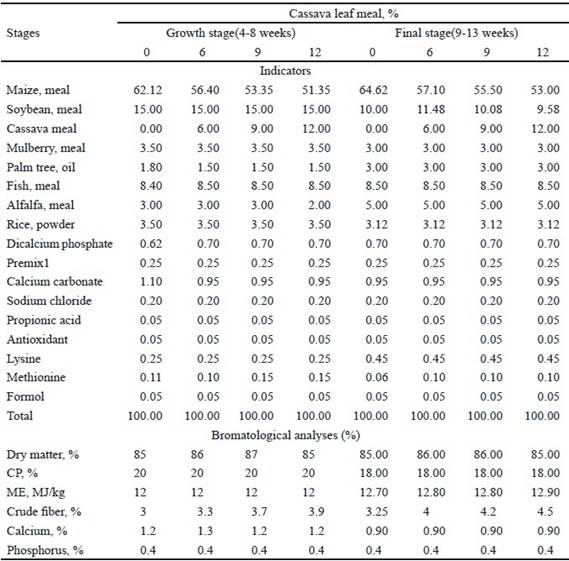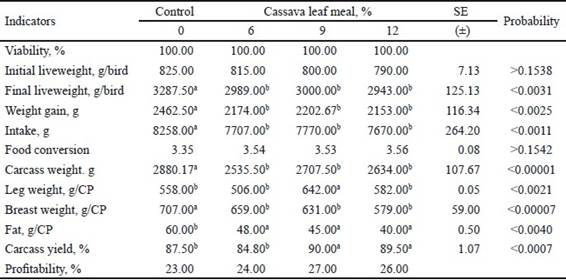Introduction
Food is the most important component for the production of birds and the availability of local inputs, and it is essential for poultry growth (FAO 2017). Currently, due to the instability of prices in the international market, the production of feeds from traditional inputs, like maize and soybeans, leads to look for alternative sources such as by-products, due to the food deficit and the need to produce larger scale with favorable results (Lezcano et al. 2015).
Cassava plant, because of its high yield in the tropics (16000 kg/ha), is a viable alternative in animal feed. Its leaves are an underutilized product in these cultivars (Hermida 2015). However, it is considered a protein source with a high content of vitamins, minerals and fiber. Its main disadvantage is the content of hydrocyanic acid (HCN), which increases with age, variety and edaphic conditions (Zeledon 2017), and decreases by means of natural dehydration (solar rays), a safe system to destroy it without affecting the action of linamarase enzyme, which acts on the cyanogenic glycosides present in the plant (Linamarin and Lotaustralin) and originate free HCN (Connolly 2017).
For decades, cassava foliage has been used in ruminant feeding as a source of bypass protein or protein used by the animal, without being consumed by ruminal bacteria (Giraldo et al. 2008). It is also used as a pigment for egg yolk in laying hens (Valdivié et al. 2010). From the nutritional point of view, the main limitation of this meal in the feeding of birds is its low ME content (5768.4 to 7093.5 MJ of ME/ kg) (Dos Santos et al. 2009).
When high levels of this foliage are used, its content of CF, tannins, and perhaps of hydrocyanic acid, can affect the performance of birds (Buitrago 2009). In this sense, the rearing birds with alternative foods is an effective way to support farmers in the search for food security, and this is of great interest for developing countries (Fumero et al. 2009).
Therefore, this study aims to describe the productive performance of naked neck chickens (Gen Nana) fed with cassava leaf meal in the diet.
Materials and Methods
The research was conducted at the State Technical University of Quevedo, Ecuador, located at 75 m o.s.l., with an average annual temperature of 24.7 °C and sandy-silt-clayey soil.
Cassava plants, sweet variety Verdecita (MCOL 1505), had six months of establishment and were fertilized with natural fertilizer. Drying of cassava leaves was performed under roof, on cement floor, for three days. Every day, they were turned in three moments to achieve a uniform drying. They were ground in hammer mill, Henkel 2040 brand, with capacity for 30 kg and 1 mm screen. Ten leaf samples (1 kg/sample) were taken and sent to the laboratory of the National Institute of Agricultural Research (INIAP 2012, initials in Spanish). According to the report of this laboratory, nutritional composition of cassava leaf meal, variety Verdecita (MCOL 1505), was 85 % of DM and 24 % of CP, with an energy value of approximately 6.8 MJ/kg, 33 % of NDF and 27 % of ADF, with 77 % of digestibility.
Ninety six naked neck broilers (Gen Nana), without sexing, were used, from 28 to 90 d of age, with mean weights between 790 and 825 g/bird. They were given a reinforcement of the vaccine against Newcastle. They were housed in a rustic shed, built of bamboo cane and zinc roof (56 m2), and 24 cages (1m2), ground floor covered with chopped bamboo cane boards and chip bed (20 cm thick). A drinking trough, a plastic feeder and a 60 watt light bulb were installed in each cage. Birds were weighed at the beginning of the experiment and every 15 d.
Weight gains and feed conversion were calculated, according to controlled intake of food. After 90 days of age, six birds/treatment were weighed and slaughtered, according to the methodology described by Sánchez (1990), to evaluate carcass performance, its main cuts (breast, thighs + drumsticks) and abdominal fat. Animals were distributed in a random block design with three experimental treatments (6, 9 and 12 % inclusion of cassava leaf meal) and a control (without inclusion of meal). Six replications were made per treatment with four birds each. For the statistical analysis of results, the computerized statistical package INFOSTAT (Di Rienzo et al. 2012) was used. In the necessary cases, mean values were compared by Duncan (1955) test.
Diets of growth and final stages were formulated in accordance with the requirement of lineage (Sasso 2012). Percentage composition and bromatological analysis is presented in table 1.
Table 1 Composition of diets

One kg of food contains: Vitamin supplement: Vitamin A (10,000 IU), Vitamin D3 (2000 IU), Vitamin E (10 mg), Vitamin K3 (2 mg), Thiamin (1 mg) -B1, Riboflavin (5 mg), Pyridoxine (2 mg) - B6, Vitamin B12 (15 mg), Nicotinic acid (125 mg), Calcium panthenol (10 mg), Folic acid (0.25 mg), and Biotin (0.02 mg). Mineral supple- ment: Selenium mineral: Selenium (0.1 mg), Iron (40 mg), Copper (12 mg), Zinc (120 mg), Mg (100 mg), Iodine (2.5 mg) and Cobalt (0.75 mg).
Results and Discussion
Viability was 100 % in all treatments, which shows that the use of up to 12 % of cassava leaf meal, as a source of protein, low in metabolizable energy, does not cause deaths in naked neck broilers (Gen Nana). It is probably due to the low content of hydrocyanic acid (1.81 ppm) in the leaves, the effect of sun drying and low content of antinutritional substances (Do Santos et al. 2009 and Zacarías et al. 2012). There were no significant differences between cassava leaf meal for final live weight, weight gain, carcass weight and drumstick+thight, but they were lower (P<0.05) than control. However, 9 and 12 % of cassava leaf meal showed higher (P<0.05) carcass yield (90, 89.5 %) and profitability (27 and 26 %), as production costs decreased. On the other hand, as the level of inclusion increased (6, 9 and 12 % cassava leaf meal), fat decreased, which is a very important factor in a demanding and growing market of consumers who take care of their health (table 2) .
These results agree with those presented by Santos et al. (2014), who worked with naked neck broilers (Gen Nana) fed with inclusions (3.6 and 9 %) of foliage of Morus alba in the diet. These authors reported that as levels increased, carcass pigmentation improved, and the abdominal fat content of birds decreased to develop leaner meats.
These properties have been attributed to the high content of xanthophylls in cassava leaves (605 mg/kg of total xanthophylls and 508 mg/kg of pigment xanthophylls), while the maize grains contains only 25 mg of total xanthophylls/kg. It has been demonstrated that high levels of fiber in rations of broilers reduce the absorption of cholesterol and lipids at intestinal level (Savón 2010). Results close to those found in this research presented by Connelly (2017), who worked with broilers and used three treatments (T1 = 100 % concentrate, T2 = cassava foliage at 5 % plus cassava root meal at 10 % and T3 = 10 % of cassava foliage and 10 % cassava root meal).
Table 2 Productive performance

a, bDifferent letter in the same line differ at P < 0.05
Duncan (1955). *p<0.05 ** p<0.01 ***p<0.001
This author found significant differences in all productive indicators. The highest values in the control or T1. However, the highest profitability was recorded in T2, due to the reduction in food expenses. It was observed that as the inclusion level of cassava leaf meal increased, the intake and weight gain of broilers decreased, without affecting food conversion. These results could be due to the presence of a larger population of lactic acid bacteria and yeasts, as well as a lower pH in the digestive area compared to those who consume diets rich in maize, which favor viability, weight gain, food conversion, carcass yield, as well as the liveweight of broilers (Promthong 2005). On the other hand, Buitrago (2009) indicates that with the use of high levels of cassava foliage in diets, its content of CF, tannins, and perhaps hydrocyanic acid, may affect the productive performance of birds because it affects diet intake.
However, Giraldo et al. (2008) indicate that diets with high levels of cassava foliage have low digestibility, which affects their productive performance. Zeledon (2017) used cassava leaf meal in broilers and reported a decrease in the productive indicators of intake, liveweight and weight gain. However, there was an increase in weight in breast, legs, less fat and an increase in economic yields. It is probable that, given the amount of digestible fiber in the diets, the intake in birds will be affected by the effect of satiety or filling that it produces. Nevertheless, the quantities used are not enough to obtain carcass with higher weight, without affecting their main cuts such as legs and their quality (flavor, color and texture), which favorably reduces fat, which is an important factor for health. It was determined that it is possible to improve egg yolk pigmentation and reduce feeding costs of laying hens, when 2.5 % of cassava foliage meal is included in diets with cassava meal and African palm oil, which are very expensive in the market. They are basic sources of starch and lipids for laying hens (Valdivié et al. 2010). The results suggest that it is possible to include up to 12 % of cassava leaf meal, without affecting the productive performance with positive profitability.











 texto en
texto en 


